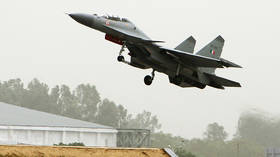Is India's new Su-30MKI fighter squadron with BrahMos missiles enough to calm China in the region?

A new Sukhoi Su-30MKI squadron, equipped with the Indo-Russian BrahMos missiles, vastly extends India's air power in the Indian Ocean. Can it help to counter the growing influence of the Chinese Navy?
In a step toward enhancing jointness, Chief of the Defense Staff General Bipin Rawat inaugurated a new squadron at Thanjavur Air Force Station in India's southern state of Tamil Nadu . “Su-30 MKI along with the BrahMos will be a gamechanger which will extensively enhance the security of the maritime domain,” Rawat said.
Also on rt.com First squadron of Su-30MKI fighter jets inducted in South India, set to watch over Indian OceanExpansion of Indian air power in the region
Indeed, the BrahMos anti-ship missile – a success story of Indo-Russian defense partnership – is a highly potent weapon boasting supersonic speeds with a range of about 300km and renders most countermeasures invalid. The missile was reportedly successfully test-fired from a Sukhoi-30MKI in May 2019, scoring a direct hit on the target. The Sukhois, which have a range of around 1,200km, significantly increase India's capability to strike targets deep in the Indian Ocean and to virtually cover most shipping lanes in the region.
The new No. 222 Squadron, named ‘Tiger Sharks', will initially have around five to six fighter jets but gradually it will operate with a full strength of 18 aircraft. This is the first fighter squadron to be set up by the Indian Air Force in its Southern Command covering the Indian Peninsula. Retired Air Vice-Marshal Manmohan Bahadur stated: “The requirement of having a permanent footprint of Indian air power over the Indian Ocean was lacking. With the basing of Sukhois at Thanjavur, this deficiency would be overcome to a certain extent due to the deep strike capabilities of the aircraft.”
Indian army shows off brand new surface-to-air missile during test launchDETAILS: https://t.co/0sUxzVrvbApic.twitter.com/wOtl8aZXc2
— RT (@RT_com) December 23, 2019
Sino-India tensions in the Indian Ocean
The last decade has seen a rise in Chinese influence in the Indian Ocean. The Chinese Navy's continued deployments and activities in the region, which seem to impinge on India's sphere of influence, have sometimes led to tensions. Just last month, the Indian Navy revealed that a Chinese naval vessel entered India's exclusive economic zone (EEZ) without approval and was asked to leave by the Indian Navy. Earlier a Chinese warship had been spotted close to the country's EEZ. The increase in Chinese activities in the Indian Ocean has resulted in an increase in Indian naval ship and air operations in the region, clearly aimed at countering Chinese influence.
With the INS Vikramaditya being the sole operational aircraft carrier in the Indian Navy's arsenal, sustaining credible surveillance and dominance in the region badly required an additional punch, and the Sukhoi squadron provides that much-needed shot in the arm. Over the next few years, it is likely that the air force could position additional aircraft at other locations such as the Andaman and Nicobar Islands, overlooking the strategic Strait of Malacca.
On balance, the BrahMos-equipped Sukhoi fighter aircraft add a new dimension to India's efforts to counter growing Chinese influence in the region.
Also on rt.com Exercise INDRA 2019: Strengthening Indo-Russian strategic tiesThe statements, views and opinions expressed in this column are solely those of the author and do not necessarily represent those of RT.













